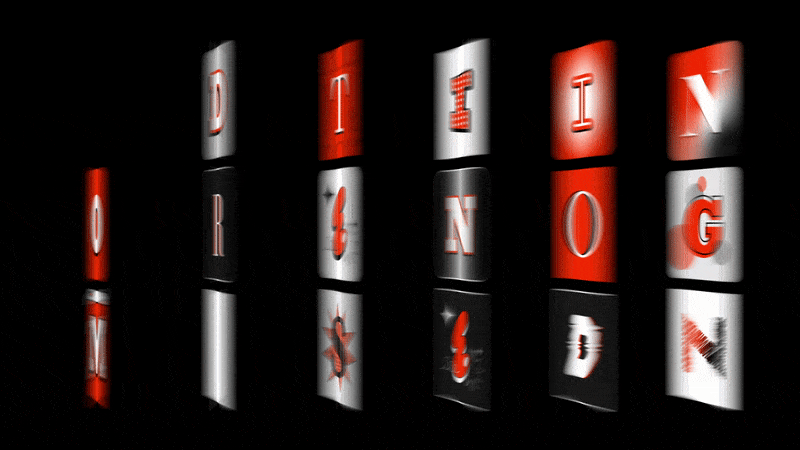Buckle up, because we’re about to dive face-first into a rabbit hole of keyframes, bezier curves, and enough industry jargon to make your old Flash animation professor weep.
If you’re part of the motion design and animation community, chances are you know Motionographer.com.
Since 2006, Motionographer has served as a vital resource for visual storytellers to hone their craft, showcase their work, and navigate the industry’s unique landscape.
This year, they released 26 trends they believe will shape the motion design industry. From AI-driven animations and eco-conscious design to physics simulations and cinematic AR experiences, there’s significant change on the horizon – even if some trends don’t make it past the runway.
Let’s explore the top trends that could add some fresh style to your B2B marketing wardrobe:
Data-Driven Design
B2B marketing is fundamentally grounded in ones and zeros – the nuts and bolts of proving your product’s value to buyers. Need a refresher? Check out Steve’s 80/20 rule. But here’s the thing: data doesn’t have to be boring. Designers are discovering innovative ways to present numbers that tell compelling stories and capture audience attention. Look no further than the New York Times’ interactive articles for masterful examples. When motion design and storytelling merge with data, they create a powerful tool for communicating facts in ways that are both compelling and memorable for your brand. Planning an annual report, event keynote, or impact video? It’s time to consider data-driven design.
Minimalist Aesthetic
We’re witnessing a design renaissance. Brands have moved past skeuomorphism shenanigans (that’s right, I had to look this one up, too) and, as Taylor Swift would say, we’re in our Minimalism Era. You’ve likely noticed the “debranding” phenomenon sweeping through logos and brand elements, driven by the demands of digital scalability. While your B2B products and solutions may be complex, your content doesn’t have to be. A minimalist approach forces you to distill your brand’s value proposition to its essence, creating a clean, sophisticated aesthetic that feels both modern and accessible to your audience.
Kinetic Typography
Let’s be honest: Kinetic typography isn’t new, but it’s playing an increasingly crucial role in modern marketing. In today’s social media landscape, where viewers often watch content without sound, kinetic typography ensures your message reaches people on the go. Whether it’s an ad, product launch animation, or thought leadership video, this technique significantly improves message recall by reinforcing key points through dynamic on-screen text. At Fifteen4, we’ve integrated kinetic typography into countless projects as a powerful tool for elevating content impact.
Loopable Animations
Notice the looping header above? These hypnotic animations dominate our digital landscape for good reason – they excel at capturing and maintaining attention. Planning a paid social campaign for your B2B brand? Consider combining loopable animations with focused messaging and compelling visuals to make your HubSpot analytics sing.
Biomorphic Design
As technology accelerates, audiences increasingly crave authentic human connections. This creates an opportunity in B2B animation: using nature-inspired design to soften technical content. Flowing curves, organic textures, and natural movements can transform rigid corporate messaging into something more approachable. Picture healthcare data flowing like water, or financial graphs growing like branches. These biomorphic elements help technical brands tell stories that resonate on a fundamental human level.
Micro Animations in UI/UX
In UI/UX design, micro animations offer something invaluable to your customers: delight. Having a functional website, SaaS product, or app isn’t enough anymore. To stay competitive, you need to surprise, inform, and delight your customers – this is where micro animations shine. Partner your development and product teams with experienced design and animation specialists to bring your UI/UX vision to life.
AI Assisted Storyboarding
Storyboarding forms the backbone of both live action and animated storytelling – and it’s incredibly time-intensive. While AI might not perfectly capture your brand’s visual style in storyboard format, it excels at quickly visualizing abstract concepts. Having these AI-generated reference points helps your creative team – whether animators, storyboard artists, or directors – move more efficiently into creating polished, brand-aligned frame sequences.
Inclusive Motion Design
While DEI initiatives may seem to have faded from headlines, overlooking inclusion in B2B animation is a critical mistake. Animation drives emotional connections with your brand, and relatability is key. Your motion design should reflect the diverse makeup of your audience, ensuring everyone sees themselves in your product or service. Beyond representation, consider accessibility: your B2B content should be easily viewable across all platforms and viewing conditions, exceeding basic compliance standards.
While trends may come and go faster than last season’s fashion faux pas, these 2025 motion design trends shouldn’t be relegated to the back of your digital closet with baggy jeans and Bermuda shorts. Motion design remains a powerful asset for getting your B2B brand noticed. So step into 2025 with style – your brand deserves nothing less.
Curious to explore motion design in your brand?

Meet blog author Sam Oddo,
Partner & Creative Director, Live Action + Animation
Read his bio here

